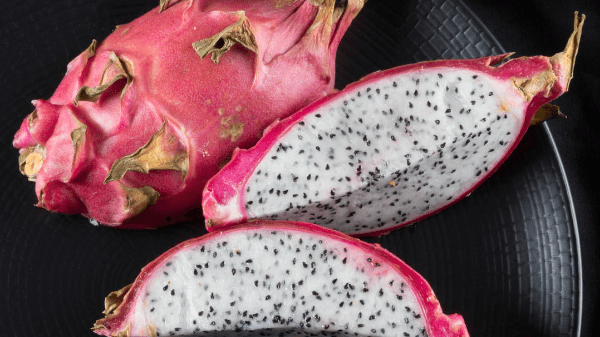My colleague Pamela Riemenschneider is understandably excited about her new pair of Nikes featuring dragonfruit. Dragonfruit gets boost from Nike, and I’m here for it – Produce Blue Book
But then I think back on my own experience with dragonfruit.
My wife bought some once. We tasted it. It was like watermelon into which somebody had stuck a syringe and sucked out all the color and flavor.

That was it for dragonfruit. Professional rigor suggests that I really ought to give it another try, and I probably will, but for now it is in my folder labeled, “Just Don’t Feel Like It.”
Then there was the jackfruit I bought. I sensibly decided to cut it up out on the deck.
When I smelled and tasted it, I was faced with a dilemma: whether to carry it to the garbage bin through the kitchen or walk it all the way around the house. (As I remember, I bravely, or lazily, took it through the kitchen.) That was it for jackfruit.
Again, I really ought to give it another try, but—see above.
Am I being unfair to these exotic fruits, which I’m sure are delicious under the right conditions? Undoubtedly. But the “just don’t feel like it” factor is an extremely powerful one.
It doesn’t apply only to unfamiliar produce items. A friend of mine introduced me to cherimoyas by calling them “the best fruit ever”—a judgment that I basically agree with.
But the last couple of cherimoyas I bought in a produce section weren’t very good. I jumped to the conclusion that I wasn’t likely to get good cherimoyas in a standard Midwestern produce section.
I believe that this “just don’t feel like it” impulse is one of the most important factors affecting produce purchases every day—and not just with exotic and unfamiliar items.
I have bought navel oranges at the beginning of the season that just weren’t that great. This did not turn me off to navel oranges forever, but it did mean that I didn’t buy any for a few weeks afterward.
The opposite is true of bananas. They are the ideal produce item for the American market: not only are they tasty, but they are reliably and regularly so. When you buy a standard Cavendish banana, whether at Whole Foods or a truckstop, you know what you are getting.
You also (like every other American) know that bananas are green when unripe, yellow when ripe, and black when overripe. It’s all extremely clear and predictable.
These qualities are essential features of the successful American product in every arena: it is good, it is familiar, and when you buy it, you know what you are getting. The same could be said for another great success: the McDonald’s hamburger.
What am I suggesting here? That when new produce items come onto the market, unfamiliarity is only one hurdle they have to overcome. They have to face the fact that to a consumer, the first such item sampled is 100 percent of the items sampled. And the consumer will make purchasing decisions accordingly.
In light of all this, I have no editorializing to do. But the “just don’t feel like it” impulse is a major, often unseen, and probably immovable factor in the adoption of new produce items.



